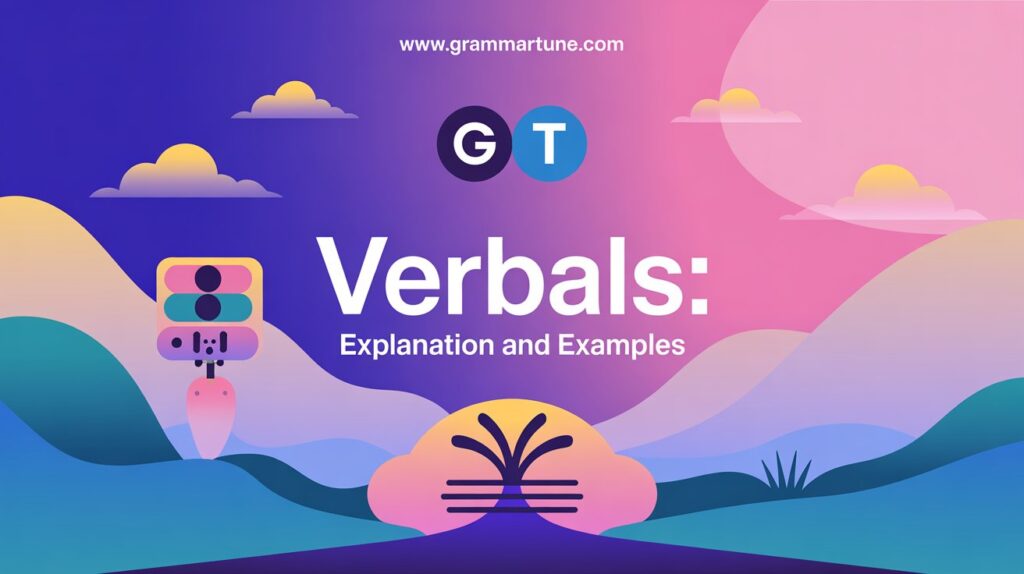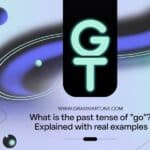Ever wondered how a simple verb can transform into something more versatile? Let’s dive into the fascinating world of verbals – those clever chameleons of English grammar that wear multiple hats.
Think of them as linguistic Swiss Army knives: they’re verbs that moonlight as other parts of speech, adding flavor and efficiency to your writing. From participles that paint vivid pictures to gerunds that turn actions into things, and infinitives that express purpose with grace, these verbal gymnastics are essential tools in any writer’s toolkit.
Whether you’re crafting a novel or composing an email, understanding verbals will revolutionize your command of language and help you express ideas with precision and style.
Table of Contents
🔍 What Are Verbals?
🖋️ What Is a Verbal in Grammar?
🌟 The Three Types of Verbal
🍂 (1) Verbals (Participles)
🌱 (2) Verbals (Gerunds)
🌿 (3) Verbals (Infinitives)
⏰ Participles for Verb Tense
💡 Why Verbals Are Important
🔑 (Reason 1) Participle phrases let you say two things efficiently
📝 (Reason 2) Gerunds can reduce your word count and improve reading flow
✂️ (Reason 3) An infinitive can usually replace “in order to”
📌 Key Points
🔄 Common Verbal Phrase Patterns
⚠️ Avoiding Common Verbal Errors
🧩 Advanced Verbal Constructions
🌎 Verbals Across Different Languages
💼 Verbals in Professional Writing
📜 Historical Evolution of Verbals
🧠 Cognitive Processing of Verbals
🎓 Pedagogical Approaches to Teaching Verbals
💻 Verbals in Digital Communication
⭐ Mastering Verbals for Enhanced Communication
Understanding Verbals in Grammar
Think of Verbals Like Actors
Imagine a verb that’s gone undercover. That’s exactly what a verbal is – it’s a verb playing different roles in your sentence. Just like an actor can play multiple characters, a verbal can act as different parts of speech.
Breaking It Down Simply:
- Basic Definition
- A verbal is a verb wearing a different grammatical hat
- It works as a noun, adjective, or adverb
- Still keeps some verb-like qualities (like describing action)
- Real-World Examples
- “I love swimming” (gerund as noun)
- “The barking dog kept me awake” (participle as adjective)
- “She came to learn” (infinitive showing purpose)
Quick Tips for Spotting Verbals:
- Look for “-ing” endings (might be gerunds or participles)
- Watch for “to” + verb (likely an infinitive)
- Notice words that show action but aren’t the main verb
What Are Verbals?
Verbals are words formed from verbs but functioning as different parts of speech in a sentence. Though derived from verbs, verbals do not act as the main action of a sentence.
Instead, they serve as nouns, adjectives, or adverbs while retaining certain verb-like qualities.
What Is a Verbal in Grammar?
In grammar, a verbal is a word that originates from a verb but does not function as the main verb in the sentence.
These verb forms take on the roles of other parts of speech while maintaining some verb characteristics such as expressing action or being modified by adverbs. The key distinction is that verbals cannot serve as the main predicate of a sentence.
The Three Types of Verbal
There are three main types of verbals in English grammar:
(1) Verbals (Participles)
Participles are verb forms that function as adjectives in sentences. They describe or modify nouns or pronouns.
- Present participles end in -ing (running, swimming, talking)
- Past participles typically end in -ed, -en, -d, -t, or -n (broken, completed, built)
Example: The screaming child would not calm down. (present participle) Example: Exhausted from the hike, Sarah took a long nap. (past participle)
(2) Verbals (Gerunds)
Gerunds are verb forms that function as nouns in sentences. They always end in -ing and can perform any role that a noun typically would.
Example: Swimming is my favorite exercise. (subject) Example: She enjoys reading mystery novels. (direct object)
(3) Verbals (Infinitives)
Infinitives are verb forms that usually include the word “to” followed by the base form of the verb. They can function as nouns, adjectives, or adverbs.
Example: I want to study medicine. (noun as direct object) Example: She has a desire to succeed. (adjective modifying “desire”) Example: He works hard to provide for his family. (adverb showing purpose)
Participles for Verb Tense
While participles can function as verbals, they also serve as components of verb tenses when combined with auxiliary verbs:
- Present participles form continuous tenses with forms of “be” Example: She is writing a novel. (present continuous)
- Past participles form perfect tenses with forms of “have” and passive voice with forms of “be” Example: They have finished the project. (present perfect) Example: The window was broken during the storm. (passive voice)
Why Verbals Are Important
(Reason 1) Participle phrases let you say two things efficiently.
Participle phrases allow writers to combine two ideas into one concise sentence, making writing more efficient and sophisticated.
Instead of: “The man was walking down the street. He was whistling a happy tune.” With participle: “The man walking down the street was whistling a happy tune.”
(Reason 2) Gerunds can reduce your word count and improve reading flow.
Gerunds provide a way to express actions as concepts or events, making sentences more concise and improving the flow of writing.
Instead of: “It is important that you exercise regularly.” With gerund: “Exercising regularly is important.”
(Reason 3) An infinitive can usually replace “in order to.”
Infinitives create more economical sentences by eliminating unnecessary words that express purpose.
Instead of: “She practiced daily in order to improve her skills.” With the infinitive: “She practiced daily to improve her skills.”
Key Points
- Verbals are derived from verbs but function as other parts of speech
- The three types are participles (adjectives), gerunds (nouns), and infinitives (nouns, adjectives, or adverbs)
- Participles also form various verb tenses when combined with auxiliaries
- Using verbals properly creates more sophisticated and concise writing
What is the basic difference between a gerund and a participle explained with examples?
The basic difference lies in their function:
- A gerund functions as a noun: “Swimming is good exercise.” (subject)
- A participle functions as an adjective: “The swimming team won the championship.” (modifies “team”)
Though both end in -ing, they serve different grammatical roles in sentences.
How do you identify a gerund and a participle?
To identify a gerund:
- Look for an -ing verb form
- Check if it functions as a noun (subject, object, complement)
- Ask if it can be replaced by a noun or pronoun
To identify a participle:
- Look for an -ing form (present) or irregular form/past tense form (past)
- Check if it modifies a noun or pronoun
- Ask if it answers “which one?” or “what kind of?” about the noun
Is bored a gerund, participle, or infinitive?
“Bored” is a past participle because:
- It’s derived from the verb “to bore”
- It ends in -ed (characteristic of many past participles)
- It functions as an adjective modifying nouns or pronouns
Example: “The bored students began passing notes.” (modifies “students”)
What are verbals explained with examples?
Verbals are verb forms that don’t function as main verbs but take on other roles:
Participle (adjective): “The crying baby needed attention.” Gerund (noun): “Crying won’t solve the problem.” Infinitive (various): “They want to cry out in protest.”
Functions of Gerunds
Gerunds can function as:
- Subject: “Reading improves vocabulary.”
- Direct object: “She enjoys swimming.”
- Subject complement: “Her hobby is painting.”
- Object of preposition: “He’s afraid of failing.”
- Indirect object: “Give studying your full attention.”
Functions of Participles
Participles can function as:
- Attributive adjective: “The running water created a soothing sound.”
- Predicate adjective: “The audience was amazed by the performance.”
- Part of a participial phrase: “Broken by years of abuse, the machine finally stopped working.”
Functions of Infinitives
Infinitives can function as:
- Subject: “To travel widely is her dream.”
- Direct object: “She wants to succeed.”
- Subject complement: “Her goal is to graduate with honors.”
- Adjective: “She needs something to eat.”
- Adverb of purpose: “They exercised to stay healthy.”
Verbal Examples
Participles:
- The smiling child approached the puppy. (present participle)
- The written document contained crucial information. (past participle)
Gerunds:
- Hiking through the forest refreshes the spirit. (subject)
- They discussed renovating the old farmhouse. (object)
Infinitives:
- He hopes to finish the project by Friday. (direct object)
- Her desire to succeed drives her hard work. (adjective)
- She works out regularly to maintain her health. (adverb)
By mastering the use of verbals, writers gain powerful tools for creating varied, sophisticated, and efficient sentences that enhance their communication.
Advanced Understanding of Verbals in Grammar
Verbals are verbs in disguise – they’re action words that function as different parts of speech (nouns, adjectives, or adverbs) while retaining some verb-like qualities.
They come in three types: gerunds (ending in -ing and acting as nouns), participles (describing like adjectives), and infinitives (starting with “to” and showing purpose).
Think of them as versatile words that add flavor to your writing while helping you express ideas more efficiently.
Common Verbal Phrase Patterns
Verbal phrases enhance your writing by adding complexity and sophistication. Understanding their structure helps you recognize and use them effectively.
Participle phrases typically include:
- The participle itself
- Objects of the action
- Modifiers providing additional information
Example: “Running toward the finish line, exhausted but determined, the athlete gave her final push.”
Gerund phrases generally contain:
- The gerund as the core
- Objects receiving the action
- Modifiers adding detail or context
Example: “Cooking elaborate meals for large groups requires careful planning.”
Infinitive phrases commonly include:
- The “to + verb” construction
- Objects of the action expressed
- Modifiers that add qualifying information
Example: “She decided to invest her savings in ethical companies that support environmental causes.”
Avoiding Common Verbal Errors
Dangling Participles
A dangling participle occurs when the participle doesn’t clearly or logically relate to the subject of the main clause.
Incorrect: “Walking down the street, the trees were beautiful.” (Trees don’t walk) Correct: “Walking down the street, I admired the beautiful trees.”
Misplaced Participles
Misplaced participles create confusion when they appear too far from the noun they modify.
Incorrect: “The teacher found a wallet containing credit cards on the playground of a student.” Correct: “The teacher found a student’s wallet containing credit cards on the playground.”
Gerund-Participle Confusion
Distinguishing between gerunds and participles can be challenging because they look identical.
- In “The swimming competition starts tomorrow,” “swimming” is a participle modifying “competition.”
- In “Swimming competitively requires dedication,” “swimming” is a gerund functioning as the subject.
Advanced Verbal Constructions
Split Infinitives
A split infinitive occurs when a word (usually an adverb) separates “to” from the base verb.
Example: “She decided to carefully examine the evidence.”
While traditionally considered an error, split infinitives are now widely accepted in modern English when they improve clarity or emphasis.
Perfect Participles
Perfect participles express an action completed before another action began.
Example: “Having finished her homework, Sarah went out with friends.”
Passive Infinitives
Passive infinitives combine the infinitive “to be” with a past participle.
Example: “He hopes to be selected for the team.”
Verbals Across Different Languages
The concept of verbals exists in many languages, though with different classifications and rules:
- In Romance languages like French and Spanish, the infinitive form doesn’t require a “to” equivalent
- Germanic languages often have verbal patterns similar to English
- Asian languages like Chinese may express verbal concepts through context rather than specific forms
Verbals in Professional Writing
Legal Documents
Legal writing frequently employs gerunds and infinitives to establish rights, responsibilities, and processes.
Example: “Failing to comply with these regulations may result in penalties.”
Technical Writing
Technical documents use participles extensively to describe processes and states.
Example: “The corroded pipe, leaking at several points, requires immediate replacement.”
Academic Writing
Scholarly texts leverage all types of verbals to express complex relationships between concepts.
Example: “Understanding the mechanism allows researchers to develop more effective treatments.”
Historical Evolution of Verbals
The development of verbals in English traces back to Old English, with significant changes during the Middle English period. Modern usage continues to evolve, with some traditional rules becoming more flexible over time.
The prescriptive grammar rules regarding verbals established in the 18th and 19th centuries have gradually given way to more descriptive approaches that acknowledge actual usage patterns.
Cognitive Processing of Verbals
Research in psycholinguistics suggests that verbals require greater cognitive processing than simple verb forms, as readers must track their dual nature—retaining verb-like qualities while functioning as different parts of speech.
This cognitive challenge actually contributes to more engaging writing, as readers must remain more actively involved in processing the text.
Pedagogical Approaches to Teaching Verbals
Language educators typically introduce verbals in a sequential order:
- Simple participles as adjectives
- Basic gerunds in subject position
- Simple infinitives as objects
- Complex verbal phrases with objects and modifiers
This scaffolded approach helps learners gradually master these sophisticated structures.
Verbals in Digital Communication
In the era of digital writing, verbals remain essential but face new challenges:
- Concise communication in social media often favors gerunds for headlines and titles
- Technical documentation in programming relies heavily on gerunds for naming functions and processes
- User experience design employs infinitives to explain user actions clearly
Mastering Verbals for Enhanced Communication
Developing proficiency with verbals gives writers powerful tools for:
- Creating sentence variety
- Achieving economy of expression
- Establishing logical relationships between ideas
- Conveying precise meanings with nuance
By strategically employing participles, gerunds, and infinitives, writers can craft prose that is both elegant and efficient, elevating their communication to professional standards across all contexts.
🏁 Conclusion
Mastering verbals transforms ordinary writing into eloquent communication. These versatile verb forms create efficiency, elegance, and precision in expressing complex ideas.
By understanding how participles modify nouns, gerunds function as powerful nouns, and infinitives serve multiple grammatical roles, writers gain essential tools for crafting sophisticated sentences. Incorporating verbals strategically reduces wordiness, creates sentence variety, and establishes clear relationships between ideas.
Whether in academic, professional, or creative contexts, proficiency with verbals elevates your writing to new levels of clarity and style, making your communication more impactful and engaging for readers
❓ FAQs
What is the basic difference between a gerund and a participle?
Gerunds function as nouns (e.g., “Swimming is fun”), while participles function as adjectives (e.g., “The swimming team”).
How do you identify a gerund and a participle?
Gerunds act as nouns and can be subjects or objects. Participants modify nouns and answer “which one?” or “what kind?”
Is “bored” a gerund, participle, or infinitive?
“Bored” is a past participle functioning as an adjective in sentences like “The bored student stared out the window.”
What are the main functions of infinitives?
Infinitives can function as nouns, adjectives, or adverbs, offering versatility in expressing purpose, desire, or intention.
How can verbals improve my writing?
Verbals create sentence variety, express complex relationships efficiently, reduce wordiness, and add sophistication to your writing.

Joulia, a seasoned wordsmith and grammar enthusiast, brings over a decade of blogging expertise to Grammar Tune. With a keen eye for linguistic precision and a passion for making complex grammar concepts accessible, he has helped thousands of readers enhance their writing skills. His engaging teaching style and practical approach to language learning have made him a trusted voice in the online grammar community.







